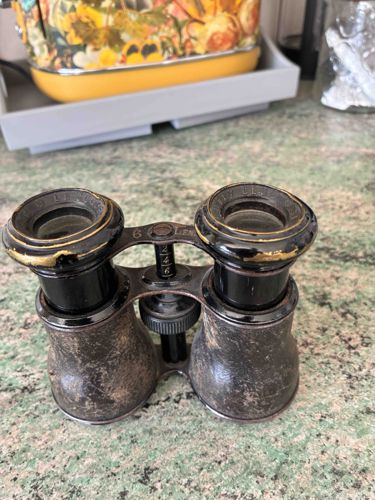
Antique Opera Glasses
This is a pair of antique opera glasses, designed for viewing performances or events from a distance. The physical characteristics include a compact and lightweight construction, making them easy to hold and transport. The main body of the binoculars appears to be made of metal, likely brass or a similar alloy, which is then covered with a dark, textured material resembling leather or lacquered paper, giving it a somewhat mottled, aged appearance with visible wear and scuff marks, revealing some of the underlying metallic surface. The brass elements, particularly around the eyepiece rims, show significant patina and some loss of their original golden finish, suggesting age. The eyepieces and objective lenses are housed in black-colored tubes, which may be ebonized wood or lacquered metal. The focus mechanism is a central thumbwheel with a ribbed edge for grip, connecting to the central bridge piece that allows the two halves to adjust for focus. The bridge piece is also metallic and dark-colored, with some numbers and text visible, though not entirely clear, showing '6' and possibly 'LENS'. The visible condition issues include significant wear to the outer covering, loss of finish on the metallic parts, and a general antique patina consistent with use and age. There are no obvious signs of major damage or repairs, but the overall condition indicates a well-used item. The style period suggests late 19th to early 20th century, common for opera glasses of this design. The craftsmanship appears to be typical for mass-produced optical instruments of that era, focusing on functionality with some decorative elements like the finished metal. The optical quality cannot be assessed from the image, but the external details highlight its historical value as a functional antique.
AI-Generated Appraisal Disclaimer
Estimated Value
$75-125
Basic Information
Category
Optical Instruments
Appraised On
November 28, 2025
Estimated Value
$75-125
Item Description
This is a pair of antique opera glasses, designed for viewing performances or events from a distance. The physical characteristics include a compact and lightweight construction, making them easy to hold and transport. The main body of the binoculars appears to be made of metal, likely brass or a similar alloy, which is then covered with a dark, textured material resembling leather or lacquered paper, giving it a somewhat mottled, aged appearance with visible wear and scuff marks, revealing some of the underlying metallic surface. The brass elements, particularly around the eyepiece rims, show significant patina and some loss of their original golden finish, suggesting age. The eyepieces and objective lenses are housed in black-colored tubes, which may be ebonized wood or lacquered metal. The focus mechanism is a central thumbwheel with a ribbed edge for grip, connecting to the central bridge piece that allows the two halves to adjust for focus. The bridge piece is also metallic and dark-colored, with some numbers and text visible, though not entirely clear, showing '6' and possibly 'LENS'. The visible condition issues include significant wear to the outer covering, loss of finish on the metallic parts, and a general antique patina consistent with use and age. There are no obvious signs of major damage or repairs, but the overall condition indicates a well-used item. The style period suggests late 19th to early 20th century, common for opera glasses of this design. The craftsmanship appears to be typical for mass-produced optical instruments of that era, focusing on functionality with some decorative elements like the finished metal. The optical quality cannot be assessed from the image, but the external details highlight its historical value as a functional antique.
Get Your Items Appraised
Instant estimates of your treasures with AI-powered instant appraisals